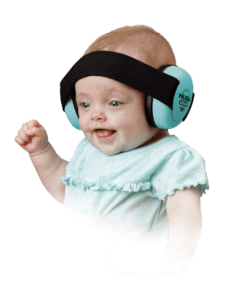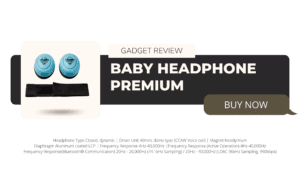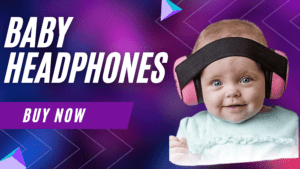In today’s bustling world, exposure to loud noises has become a commonplace occurrence. While adults can take measures to protect their ears, babies and toddlers are often left vulnerable to potential harm caused by excessive noise.
As responsible caregivers, it’s crucial to prioritize the auditory health of our youngest members. One effective solution gaining popularity is the use of baby noise cancelling headphones designed to provide ear protection and noise cancellation. In this article, we will delve into the benefits of these specialized colourful headphones, their features, and considerations when choosing the right pair for your child.
The Need for Ear Protection
Babies and toddlers possess delicate auditory systems that are still in the process of development. Exposure to loud noises at an early age can lead to irreversible hearing damage.
This vulnerability underscores the importance of safeguarding their hearing, especially in environments where noise levels are beyond their control. Baby headphones step in as a valuable tool to shield their ears from harm while allowing them to engage with their surroundings.
Benefits of Baby Headphones
Noise Reduction:
Baby noise cancelling headphones are equipped with noise reduction technology that minimizes the impact of loud sounds on a child’s ears. This feature ensures that even in noisy environments like airports or concerts, a baby’s sensitive hearing is not compromised.
Focus and Comfort:
These headphones help babies and toddlers stay focused and relaxed by blocking out distractions. Whether it’s during travel, naptime, or playtime, noise cancellation allows for a more comfortable and conducive environment.

Language Development:
Excessive background noise can hinder language development in young children. By reducing ambient noise, headphones for babies facilitate clearer auditory experiences, which are vital for language acquisition.
Sleep Aid:
Babies are often sensitive to abrupt sounds that can disrupt their sleep patterns. Noise cancelling headphones can be particularly useful in ensuring peaceful nap times and uninterrupted nighttime sleep.
Features to Look For
Adjustable Headband:
Opt for headphones with adjustable headbands to ensure a secure yet comfortable fit as your child grows.
Soft Padding:
Look for the best headphones with soft cushioning that sits gently on your child’s head. Comfort is key, especially for prolonged usage.
Volume Limiting:
Some headphones come with built-in volume limiting features to prevent audio levels from reaching harmful levels. This is crucial to prevent accidental overexposure.
Durable Build:
Babies and toddlers can be quite active. Choose headphones made from durable materials that can withstand the inevitable wear and tear.
Ease of Cleaning:
Hygiene is paramount, so select headphones that are easy to clean without compromising their functionality.
Battery Life:
If opting for noise cancelling headphones for babies, check the battery life to ensure they last through extended periods of use.
Considerations and Safety Measures
Age Appropriateness:
Ensure that the headphones are designed for your child’s age group. The fit and features should align with their developmental stage.
Supervision:
While headphones for b are designed with safety in mind, constant supervision is still necessary during use, especially with younger children.
Comfort Trials:
- Before embarking on a long journey or extended usage, conduct short comfort trials to ensure your child is at ease wearing the colourful headphones.
- Balance with Quiet Time:
- While baby noise cancelling headphones offer valuable protection, it’s equally important for babies and toddlers to have quiet, natural auditory experiences that contribute to their sensory development.
Detailed Product Overview
Baby headphones designed for ear protection and noise cancellation are essential tools for ensuring the auditory well-being of infants and toddlers in noisy environments.
They are specifically designed to provide a comfortable and safe listening experience, protecting young ears from potentially harmful loud noises. Here’s a detailed overview of key features you might find in such headphones:
Noise Reduction Rating (NRR):
The NRR indicates the level of noise reduction provided by the headphones for babies. A higher NRR value implies better noise attenuation. Look for headphones with a high NRR to ensure effective noise cancellation.
Adjustable Headband:
An adjustable headband ensures a secure and comfortable fit on babies and toddlers of various head sizes. It prevents the best headphones from slipping off and ensures proper noise isolation.

Soft Padding:
Cushioned padding around the ear cups and headband enhances comfort, making it suitable for extended wear. Soft materials prevent discomfort or pressure on the child’s head.
Safety Certifications:
Look for headphones that comply with safety regulations and certifications for children’s products. This ensures that the headphones are free from harmful materials and meet quality standards.
Volume Limiting:
Volume limiting or sound restriction technology is crucial to prevent the headphones from producing sounds that could potentially damage delicate young ears. It’s recommended to choose headphones with a maximum volume of around 85 dB to ensure safe listening.
Noise Cancellation Technology:
Active noise cancellation technology reduces ambient sounds by generating anti-noise frequencies. This helps to create a quieter environment without the need to increase the volume, which can be beneficial for babies’ and toddlers’ hearing health.
Audio Quality:
While the primary goal is to protect hearing, having decent audio quality ensures that the best headphones for babies can deliver clear sound at safe listening levels. Balanced sound reproduction can enhance the listening experience for babies and toddlers.
Durability:
Babies and toddlers can be rough on their belongings. Look for headphones with sturdy construction that can withstand drops and everyday wear and tear.
Easy Cleaning:
Children’s headphones are likely to get dirty, so choose ones with easy-to-clean materials to maintain hygiene.
Design and Colours:
Vibrant colours and fun designs can make the colourful headphones more appealing to children, encouraging them to wear them without resistance.
Battery Life:
If the headphones have active noise cancellation or other electronics, consider battery life. Longer battery life ensures uninterrupted use during long trips or outings.
Portability:
Compact, foldable, or collapsible designs make it easier to carry the headphones in a diaper bag or backpack.
Wired vs. Wireless:
Choose between wired and wireless options based on your preference. Wired headphones don’t require charging but might have cords that need management, while wireless ones offer more freedom but require occasional charging.
Adjustable Ear Cups:
Some headphones come with adjustable ear cups that can be rotated or tilted to fit different head shapes and sizes.
Breathable Materials:
Babies can be sensitive to heat, so best headphones made from breathable materials can prevent discomfort during prolonged wear.
When selecting headphones for Babies, prioritize safety, comfort, and noise protection. Always supervise your child while they’re using headphones and ensure that the volume is set at a safe level. It’s also a good idea to consult with your pediatrician before using any type of headphones on your baby or toddler, especially if you have concerns about their hearing health.
Buyer Guide
When it comes to selecting headphones for babies and toddlers, ensuring their safety and comfort is paramount. Noise protection and noise cancelling features are particularly important to protect delicate young ears. Here’s a comprehensive buyer’s guide with key features to consider:
-
Age Appropriate:
Choose headphones specifically designed for babies and toddlers. These headphones typically have smaller sizes, adjustable headbands, and softer materials to ensure a snug and comfortable fit.
-
Noise Protection:
Look for headphones with adequate noise protection. They should be designed to reduce external noise levels to a safe and comfortable range. Noise protection is crucial to prevent potential hearing damage in young and sensitive ears.
-
Noise Cancelling:
Opt for colourful headphones with noise cancelling technology. Noise cancelling headphones actively reduce ambient noise by generating sound waves that cancel out incoming noise. This feature is especially useful in environments with constant background noise, such as during travel or in crowded places.
-
Volume Limiting:
Choose headphones that have built-in volume limiting features. Excessive volume can be harmful to a child’s hearing. Look for headphones that cap the maximum volume at safe levels, usually around 85 decibels (dB), which is the recommended limit for prolonged exposure.
-
Comfort and Fit:
Comfort is crucial, especially for young children. Look for headphones with padded ear cushions and an adjustable headband to ensure a secure yet comfortable fit. Avoid headphones that might squeeze or press on the child’s ears too tightly.
-
Durability:
Babies and toddlers can be rough on their belongings. Choose headphones made from durable materials that can withstand drops, spills, and general wear and tear.
-
Wired or Wireless:
Decide whether you prefer wired or wireless headphones for your child. Wired headphones don’t require charging but can pose a tangling hazard. Wireless headphones offer more freedom of movement but need to be charged regularly.
-
Easy Controls:
Opt for headphones with easy-to-use controls. Simple buttons or switches are preferable, especially for toddlers who might want to adjust settings themselves.
-
Hygiene and Cleaning:
Children’s headphones can get dirty quickly. Choose headphones with removable and washable ear cushions for easy cleaning and maintenance.
-
Brand Reputation and Reviews:
Stick to reputable brands known for producing safe and quality children’s products. Reading reviews from other parents can provide insights into the real-world performance and durability of the headphones.
-
Compliance with Regulations:
Ensure that the headphones for babies meet relevant safety and quality standards for children’s products, such as the Consumer Product Safety Improvement Act (CPSIA) in the United States.
-
Warranty and Customer Support:
Check if the headphones come with a warranty and reliable customer support in case you encounter any issues with the product.
Remember, the primary goal of these headphones is to protect your child’s hearing while providing an enjoyable listening experience. Prioritize safety and comfort, and make an informed decision based on the features that align with your needs and preferences.
Pros and Cons
Pros of Baby Headphones for Ear Protection and Noise Cancelling:
-
Hearing Protection:
Babies and toddlers have sensitive ears that are more susceptible to loud noises. Baby headphones designed for ear protection can help reduce the risk of hearing damage caused by loud environments, such as concerts, festivals, or aeroplane travel.
-
Noise Reduction:
Noise cancelling headphones can create a quieter and more peaceful environment for babies and toddlers. This can be especially useful in noisy settings, allowing them to rest, sleep, or focus better.
-
Comfort:
Baby noise cancelling headphones are designed with the comfort of young children in mind. They are typically lightweight, adjustable, and padded to ensure a snug and comfortable fit on a baby’s or toddler’s head.
-
Travel Convenience:
Baby headphones can be valuable during travel, whether on aeroplanes, trains, or buses. They can help reduce the stress and discomfort that loud engine noises can cause for little ones.

-
Minimized Sensory Overload:
Noise cancelling headphones can help children cope with sensory overload in busy or overwhelming environments, making it easier for them to engage with their surroundings without becoming overstimulated.
-
Promotes Concentration:
In quieter settings, noise cancelling headphones can help toddlers and older children focus on activities, such as reading or playing games, by eliminating distractions.
Cons of Baby noise cancelling Headphones for Ear Protection and Noise Cancelling:
-
Potential Discomfort:
While many baby headphones are designed for comfort, some children might still find them uncomfortable to wear for extended periods. It might take time for them to get used to wearing the best headphones.
-
Safety Concerns:
Parents should exercise caution when using headphones with very young babies. The headphones should not interfere with a baby’s ability to hear important sounds, such as a parent’s voice or a smoke alarm.
-
Dependency:
Depending on colourful headphones for noise reduction might lead to dependency, where children struggle to adapt to regular, noisy environments without them.
-
Social Isolation:
Over Reliance on noise cancelling headphones might hinder a child’s ability to interact and engage with their surroundings, especially in social settings.
-
Limited Effectiveness:
Noise cancelling technology might not completely eliminate all noises, especially sudden or sharp sounds. Parents should not solely rely on best headphones for protecting their child’s ears.
-
Potential Developmental Concerns:
Some experts raise concerns that consistently blocking out environmental sounds might impact language development and the ability to learn from the surrounding environment.
When considering using baby noise cancelling headphones for ear protection and noise cancelling, it’s important for parents to strike a balance between providing comfort and protection and ensuring their child’s healthy sensory development and engagement with the world around them. Consulting with paediatricians or child development experts can provide personalised guidance based on the child’s specific needs and circumstances.
Conclusion
In an increasingly noisy world, safeguarding our children’s hearing has become an essential responsibility. Baby headphones equipped with ear protection and noise cancelling capabilities offer a practical solution to mitigate the risks associated with excessive noise exposure.
By selecting the right pair, considering features, and adhering to safety measures, caregivers can provide babies and toddlers with a more comfortable, focused, and secure auditory environment, thus nurturing their healthy growth and development.
